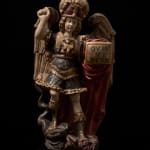Saint Michael the Archangel
Unknown artist
Ayacucho (Peru), 17th century
Carved Huamanga stone, encaustic polychrome, gold leaf estofado
Ayacucho (Peru), 17th century
Carved Huamanga stone, encaustic polychrome, gold leaf estofado
64 x 36 cm
Provenance
Private collection, Spain
Sculptures made of Huamanga stone were executed using two basic methods, one involving free-standing or ronde-bosse images, either individually or forming groups, and the other, the so-called “de arrimo”, which is the one used for the St. Michael we are presenting here, which were sculptures in high relief with flat backs and profusely carved fronts. This is the older of the two methods, with this type of relief work practiced in the city of Huamanga since the earliest times, being somewhat reminiscent of wooden altarpieces from churches.
Read Essay



